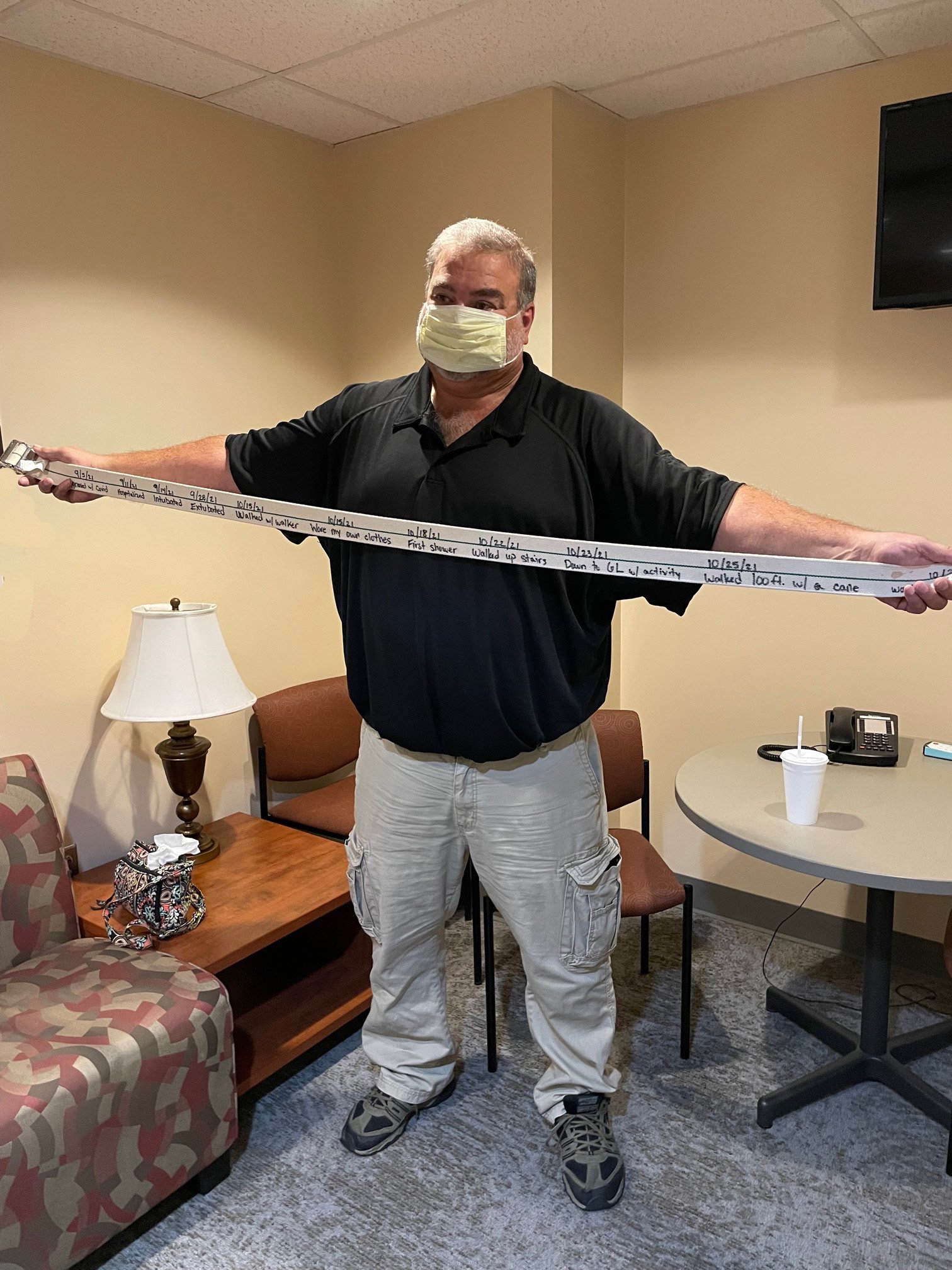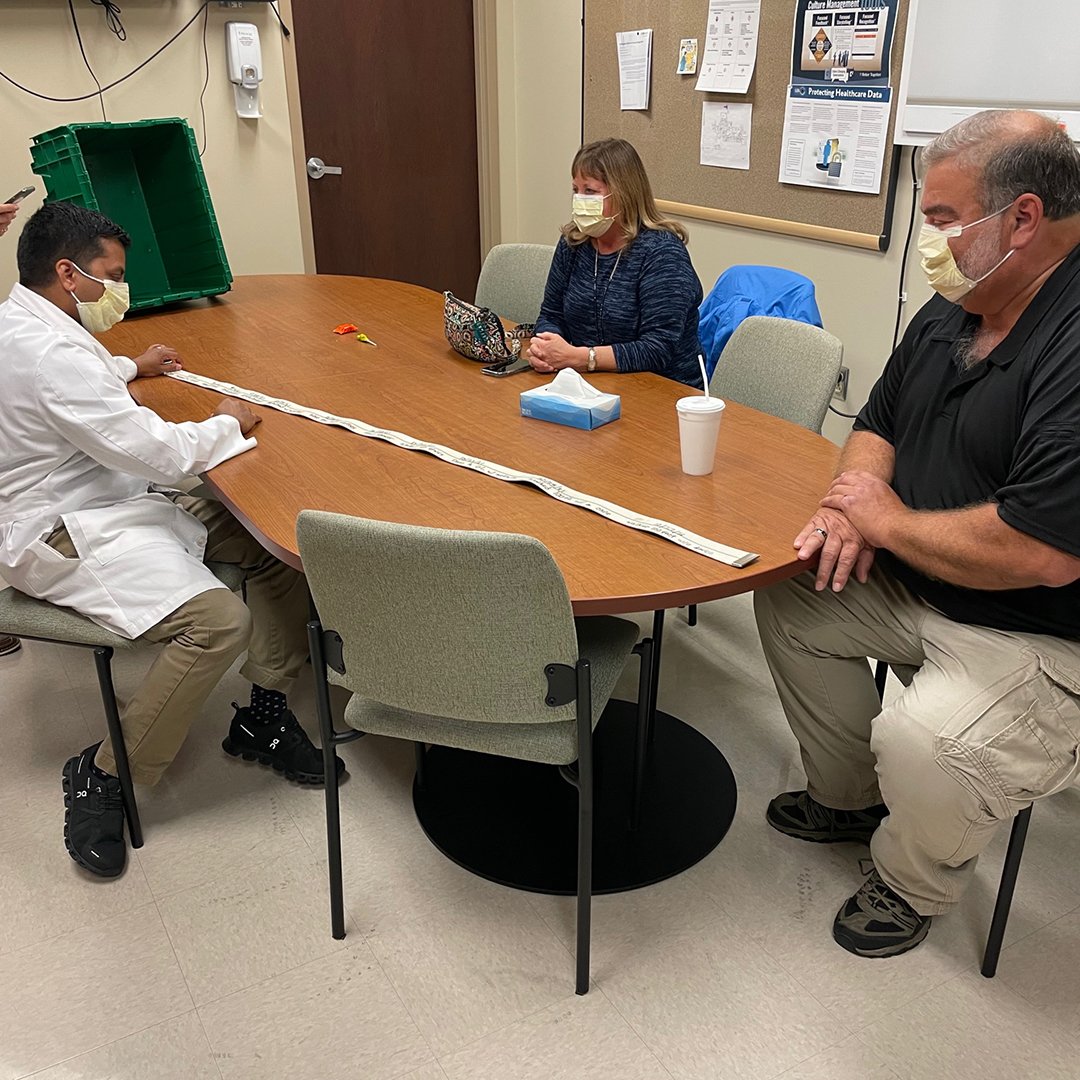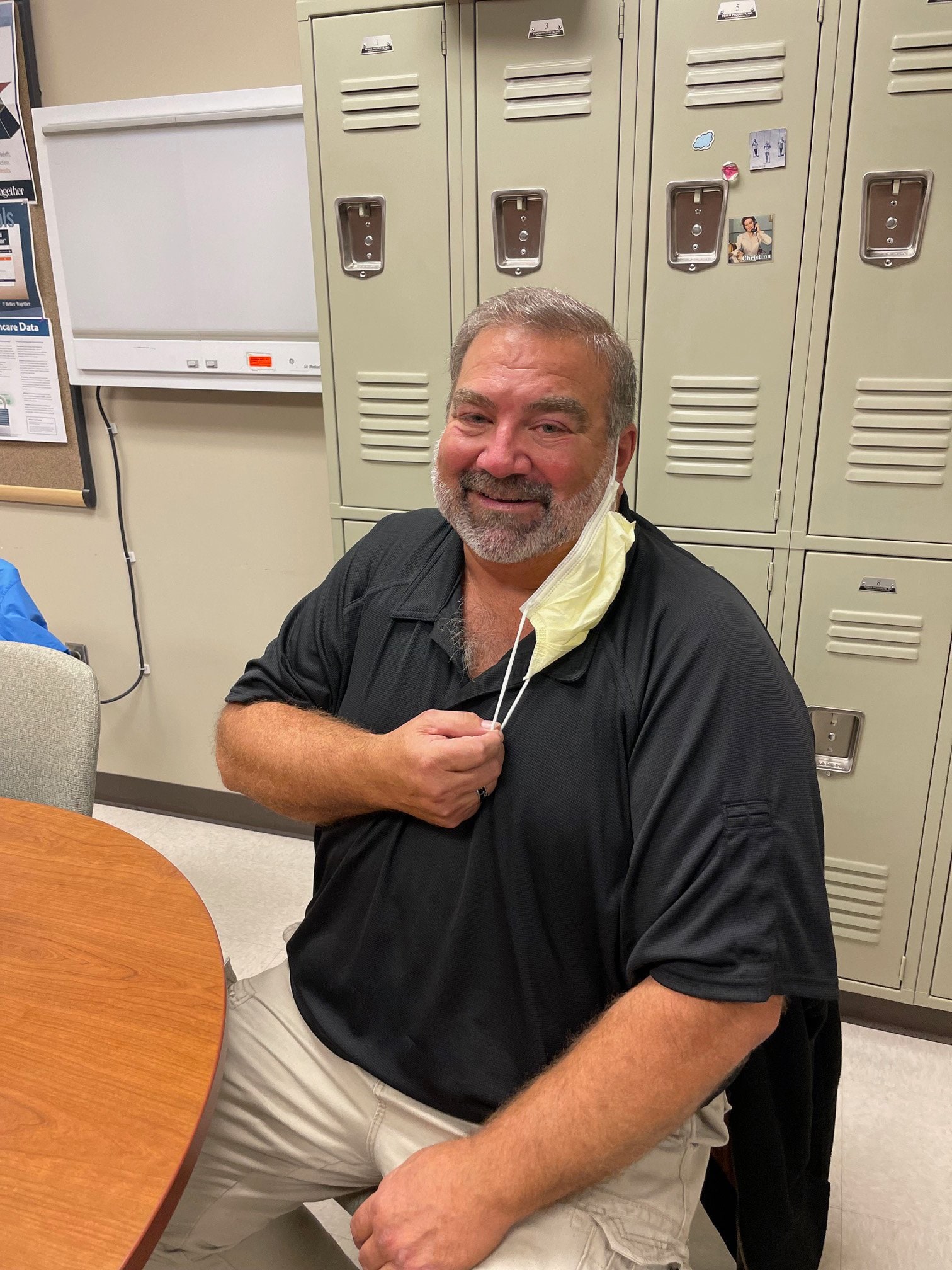To hell and back: A journey through COVID-19
When Mike Stephens holds up his gait belt, you can see that he’s been through a lot. He can look at the dates written on the belt with Sharpie and walk you through every milestone in his battle with COVID-19.

Mike Stephens displays his gait belt
It all began one September morning when he wasn’t feeling good and knew something wasn’t quite right. The next day, Mike tested positive for COVID-19. That was Sunday, September 5, 2021. By the following Friday, his life changed in ways he couldn’t have imagined.
“I was in the shower and started coughing up this brown stuff and blood,” he said. “I got out and was standing there shaving when I started to get very lightheaded, so I thought, ‘I’m going to go lay down.’ When I came to, I’d only made it halfway in the bed.”
Mike was hoping that he’d start to feel better over the weekend, but when he took a shower on Saturday, the coughing began again and Mike knew it was time to get help. He couldn’t even walk from the bathroom to the bedroom without being out of breath.
“I live by myself, so I’d called 911 earlier and told them what was going on. I wanted them to know what they were walking into if they got a call from my address,” he explained.
The paramedics rushed Mike to LMH Health where his road to recovery began.
Terrifying days
The trip to the emergency department was a blur. Mike remembers that his doctor was very nice and efficient, but it wasn’t until that evening that people came more into focus. He remembers his nurse, Heather, who shares the same name as his girlfriend Laurie’s daughter. He also remembers the respiratory therapist who wanted him placed on a floor where she could monitor him more closely.

Krishna Rangarajan, MD
Mike’s son called to talk with him the next day. When he asked how Mike was doing, the answer was blunt. He was doing everything he could to stay off the vent because if he was intubated, there was a good chance that he might not make it. Krishna Rangarajan, MD, a pulmonologist with Lawrence Pulmonary Specialists, saw Mike for the first time a couple of days later.
“I took over from Dr. (Mitchell) Tener as his pulmonologist on September 14,” Dr. Rangarajan said. “He was on BiPAP, which is a non-invasive ventilator, and required a lot of oxygen. He got pretty sick pretty quickly.”
Dr. Rangarajan recalled that Mike became more short of breath and anxious as his condition began to deteriorate more rapidly a few days later. It was at that point that he delivered some harrowing news. Mike was being put on a ventilator.
“Once you go on the vent, it’s the end. You saw on TV that all these people were dying,” Mike choked. “I remember my last prayer – it was very short and sweet. ‘God, please forgive me of my sins and through your grace and mercy, accept me into heaven.’”
The team had some trouble with the intubation. Mike didn’t have a lot of reserve and his oxygen saturation dropped to a dangerously low level when one of his lungs partially collapsed. Dr. Rangarajan and Dr. Ralph Park were able to place a chest tube and re-inflate it. The slow process of recovering was underway.
Back into the light
Over the next few days, two more pulmonologists – Amanda Gudgell, DO, and Rashid Riaz, MD – and a number of other providers cycled through to help care for Mike. After two weeks, the team determined that the ventilator had done its job. Mike was well enough to start breathing on his own again.
“I’ll never forget Dr. Gudgell. When they brought me off the vent, I just heard a woman’s voice in my ear, and it was over and over,” Mike said. “I finally got to where I could acknowledge it and know she was there with me.
“I don’t know where she had her phone, but she grabbed it and started to video chat with my brother to tell him I was awake. ‘Yes, he’s here. He’s alive. He’s alive.’”
His family felt fear every time the hospital called. They knew that it might not have been the call they had been praying for.
“When I saw it was the nurse calling, I’d grab my phone and take it outside before I’d answer it,” said Laurie Bratton, Mike’s girlfriend. “I didn’t know if that call was going to be the one to tell me that it was his death day.”
It wasn’t Mike’s time to go. This was the beginning of the battle for the rest of his life.
The battle begins
Coming off a ventilator isn’t an easy task. Patients don’t spring up and head home a couple of days later. It’s a long, lonely road to recovery.
“When I first came off the vent, I just asked why? Why did I live? I couldn’t even lift my arm, couldn’t pick up my cell phone or give myself a drink of water,” Mike said. “I didn’t have any strength and couldn’t even push the button to call the nurse.”
During his recovery, Mike was quarantined in his hospital room. Staff and nurses came in and out throughout the day, but they could only stay for short periods of time. Mike was alone with his thoughts for much of the day. He tried to make sense of it all and did a lot of praying.
“I had to learn how to do everything, the simplest of tasks, all over again. Everything I took for granted – brushing my teeth, bathing myself and getting dressed, and I was struggling,” he explained. ”Dr. Gudgell came in and said, ‘Mike, you’ve got to pull this around. You’re going to start getting better.’ And that’s what I did.”
One of the people that helped Mike during those low times was LMH Health’s spiritual care manager, Robin Colerick-Shinkle. When he was able to come out of COVID isolation, she would visit his room and sit for a long time just to talk.
“In an environment that is so fast and busy, we can easily forget how powerful it is to sit with someone, listen to their story and just be present to all they are experiencing and have been through. There is a simple healing in being heard and being known,” she said. “The experience of COVID can be life-changing, and we need someone to sit with us and help us begin processing the many layers of feelings and fears, unpacking what all of this means. For Mike, it was a journey of faith and he could see God’s faithful and abiding presence with him and his family through every day of his healing.”
Re-learning the simple things
Once he was strong enough, Mike was transferred to a Kansas City area hospital to begin the rehab process. The unknown was terrifying. Would he be able to walk again? How much of what he was able to do before would come back? Dr. Rangarajan was confident that Mike would land on his feet.

Mike and Laurie meet with Dr. Rangarajan
“Mike was one of the sickest COVID patients that we’ve had who we’ve been able to take off the ventilator,” Dr. Rangarajan said. “I saw Mike right before he left for rehab. He looked so much better – so jovial and so motivated.”
Rehab helped Mike re-learn how to do routine tasks like walking, bathing and brushing his teeth all over again. When the therapist came in to do an assessment on his first day, Mike was able to walk 25 feet using a walker. 35 feet came soon thereafter and after that, everything came in 100 foot increments.
When Mike transferred to the rehab facility, he told the LMH Health staff that he’d be back. He knew that he wanted to return to thank the doctors, nurses and staff for the lifesaving care they provided.
“There have been a few patients that we see back for follow up after discharge or they just stop by to say hello. Mike looked really good. COVID is still something he’s working to recover from, but he looks so much better.”
Kelli Averill was one of the ICU nurses who cared for Mike during his stay at LMH. Caring for patients with COVID had been difficult. Many times she’d see the worst possible outcome, with patients losing their battle with the virus. In other cases, it felt like no matter what care she provided, patients continued to feel miserable. When Mike walked back on the unit, she was overwhelmed.
“I was immediately emotional,” Kelli explained. “Getting to see Mike up and walking and on room air – wow, it was special. I’m so happy that he’s doing so well. It made my heart swell that he took the time to come back to see us and thank us for the care we gave him.”
Looking back

Mike Stephens
Since Mike’s release from rehab, he isn’t quite back to normal but he’s continued to get stronger and stronger. He still enjoys hunting, fishing and doing anything outside, and returned to his job as a truck driver in early July.
One thing Mike emphasizes to people that hear his story is the importance of getting the COVID vaccine and recommended boosters. He had received the Johnson & Johnson COVID-19 vaccine about eight months before his hospitalization. Unfortunately, the vaccine’s effectiveness had waned by the time he caught the virus.
“The shots don’t stop you from getting it, but it stops you from ending up in the hospital or from staying there for an extended time,” Mike said. “If you don’t get your shots and don’t believe in COVID, you’re going to die a believer.”